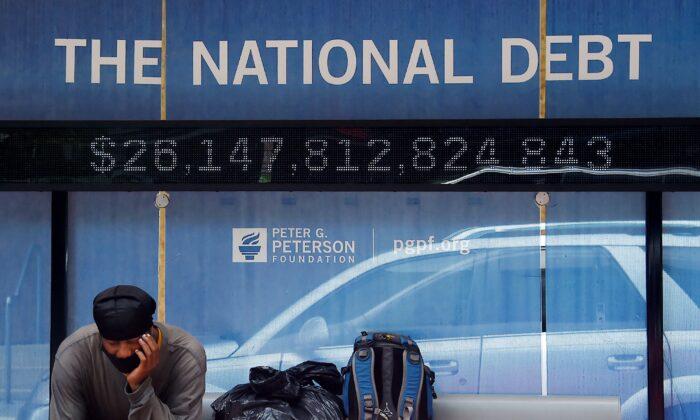But spending amid the pandemic represents only a small portion of the total difference between the official government figure and TIA’s calculation.
“Our measure of the government’s financial condition includes reported federal assets and liabilities, as well as promised, but not funded, Social Security and Medicare benefits,” the report stated.
“Elected and non-elected officials have made repeated financial decisions that have left the federal government with a debt burden of $123.11 trillion, including unfunded Social Security and Medicare promises.”
The TIA report includes in its total debt calculation $55.12 trillion in unfunded Medicare benefits and $41.20 trillion in unfunded Social Security benefits.
Treasury officials don’t include unfunded benefits because they claim recipients have no right to future payments, only to those under current entitlement laws.
The total debt, according to the report, “equates to a $796,000 burden for every federal taxpayer. Because the federal government would need such a vast amount of money from taxpayers to cover this debt, it received an ‘F’ grade for its financial condition.”
Unlike many state governments, the federal government doesn’t maintain a cash reserve to deal with spending necessitated by unexpected crises such as a virus pandemic.
“The coronavirus pandemic and related stimulus packages have caused some of the deterioration because the government had to borrow money to weather the pandemic. If the federal government was properly prepared for a crisis with a true rainy-day fund, it would not have had to borrow money,” TIA stated.
Responses
Spokesmen for Sen. Bernie Sanders (I-Vt.) and Sen. Lindsey Graham (R-S.C.), respectively the chairman and ranking minority member of the Senate Budget Committee, didn’t respond to The Epoch Times request for comment.Similarly, a spokesman for House Budget Committee Chairman Rep. John Yarmuth (D-Ky.), didn’t respond.
Mondays are typically “travel days” for senators returning from their states and representatives from the districts.
“Washington Democrats are embracing an historically disturbing appetite for spending. They just passed a nearly $2 Trillion bailout bill. President Biden is now proposing they turn right back around and cut a check for another $2 trillion to spend on a massive grab bag of policies all tied together with talking points,” Smith wrote.
Consultants Agree
Campaign strategists and nonprofit activists interviewed by The Epoch Times about the TIA report expressed agreement that debt requires serious attention to get it under control.But, Manley said, “in the meantime interest rates are low and the economy is digging itself out of the hole the pandemic caused, but there is no reason for Democrats to be at all concerned about the Republicans’ new-found focus on cutting spending after everything the last administration did.”
He was referring, he said, to 2017 tax reform legislation enacted by Republican majorities in the House and Senate and signed into law by President Donald Trump.
Chavous said he expects “the infrastructure bill will create jobs and grow the economy by investing in modern technology and cleaner energy sources. Things like a nationalized electric grid and expanded broadband access will make Americans more productive and more competitive in the years to come. It is an expense we have to make sooner than later.”
Williams said Biden and congressional leaders “are seemingly oblivious to the stark fiscal crisis happening right under their noses. Worse yet, if they are aware of the deep financial issues, they are clearly not doing anything to fix the problem. Instead of finding ways to spend more money, Congress and the president need to find ways to cut spending.”
Schatz said he believes “members of Congress have an obligation to attempt to bring spending under control and ensure that present and future taxpayers are not forced to fund any federal program that is duplicative, wasteful, and inefficient.”
When The Epoch Times asked TIA President Sheila Weinberg if it’s reasonable to depend upon future economic growth to solve the debt problem, she said no, and noted that the Treasury Department agrees.
“The authors of the Financial Report of the U.S. Government have deemed that under current law and policy, a massive implied increase in the ratio of reported debt to GDP—e.g. future debt will be growing faster than GDP—is simply unsustainable,” she said.
“In other words, under current law and policy, we can’t grow our way out of this, especially considering Medicare grows faster than inflation.”





